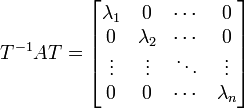Engineering Analysis/Diagonalization
< Engineering AnalysisSimilarity
Matrices A and B are said to be similar to one another if there exists an invertable matrix T such that:
If there exists such a matrix T, the matrices are similar. Similar matrices have the same eigenvalues. If A has eigenvectors v1, v2 ..., then B has eigenvectors u given by:
Matrix Diagonalization
Some matricies are similar to diagonal matrices using a transition matrix, T. We will say that matrix A is diagonalizable if the following equation can be satisfied:
Where D is a diagonal matrix. An n × n square matrix is diagonalizable if and only if it has n linearly independent eigenvectors.
Transition Matrix
If an n × n square matrix has n distinct eigenvalues λ, and therefore n distinct eigenvectors v, we can create a transition matrix T as:
And transforming matrix X gives us:
Therefore, if the matrix has n distinct eigenvalues, the matrix is diagonalizable, and the diagonal entries of the diagonal matrix are the corresponding eigenvalues of the matrix.
Complex Eigenvalues
Consider the situation where a matrix A has 1 or more complex conjugate eigenvalue pairs. The eigenvectors of A will also be complex. The resulting diagonal matrix D will have the complex eigenvalues as the diagonal entries. In engineering situations, it is often not a good idea to deal with complex matrices, so other matrix transformations can be used to create matrices that are "nearly diagonal".
Generalized Eigenvectors
If the matrix A does not have a complete set of eigenvectors, that is, that they have d eigenvectors and n - d generalized eigenvectors, then the matrix A is not diagonalizable. However, the next best thing is acheived, and matrix A can be transformed into a Jordan Cannonical Matrix. Each set of generalized eigenvectors that are formed from a single eigenvector basis will create a jordan block. All the distinct eigenvectors that do not spawn any generalized eigenvectors will form a diagonal block in the Jordan matrix.



![T = [v_1 v_2 ... v_n]](../I/m/1dc65be842059939a1b8ef827977c628.png)
